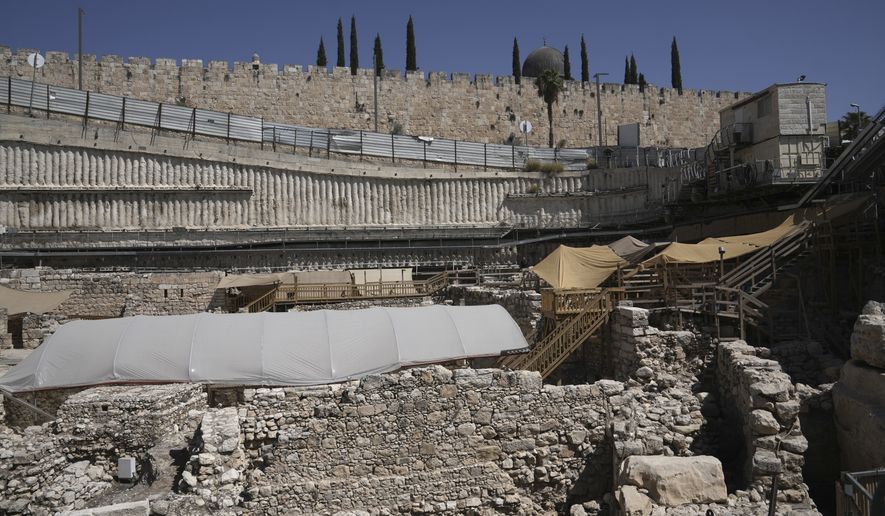OPINION:
A version of this story appeared in the Higher Ground newsletter from The Washington Times. Click here to receive Higher Ground delivered directly to your inbox each Sunday.
Does the Bible tell a true account of God’s creation and relationship with humanity? This timeless question is at the center of a plethora of theological debates and skirmishes.
While one’s affirmative position rests largely upon faith in the unseen and eternal, archaeology is among the growing tools adding factual credence to the stories and claims in the Old and New Testaments.
As time goes on, some incredible discoveries not only seem to corroborate biblical events, but they also enlighten and provide context to the cultural happenings and discussions we see unfolding within the pages of the scriptures.
The first of these discoveries worth noting is the site in Jerusalem where Jesus is said to have healed a blind man — a story recounted in John 9.
Archaeologists recently uncovered the vast majority of the Pool of Siloam, a location mentioned in the Old and New Testaments. Part of the area had already been accessible, but the latest dig helped bring much more of it to light.
As it turns out, it’s an incredibly important biblical location.
“The half-mile running through the City of David, from the Pool of Siloam in the south, continuing along the Pilgrimage Road, up to the footsteps of the Western Wall, Southern Steps and Temple Mount, represents the most significant half-mile on the planet,” Ze’ev Orenstein, international affairs director for the City of David Foundation, told Fox News in the fall.
Another enthralling find surrounds King David, arguably one of the most central figures in the entirety of the Bible. The Old Testament Israeli ruler’s kingdom and influence have often been the subject of debate among academics.
Professor Yosef Garfinkel of the Institute of Archaeology at Hebrew University wrote in the Jerusalem Journal of Archaeology that a series of five cities he researched dating to 1,000 B.C. shared similarities that could add credence to the Bible’s claim that David oversaw a vast empire.
“We now have a completely different picture than we did 50 years ago,” Michael Hasel, professor of Near Eastern studies and archaeology at Southern Adventist University, told Christianity Today last year, pointing to growing findings backing David’s sweeping empire.
It’s also worth noting that David’s historical existence wasn’t even affirmed by archeologists until 1993 with the finding of the Tel Dan inscription, a stone slab offering the first real-life evidence of his life. As the Biblical Archeology Society notes, “The broken and fragmentary inscription commemorates the victory of an Aramean king over his two southern neighbors: the ‘king of Israel’ and the ‘king of the House of David.’”
Experts also have uncovered information on other biblical leaders as well, including Hezekiah, one of the kings of Judah.
Professor Gershon Galil at Haifa University’s Institute for Biblical Studies and Ancient History and Eli Shukron of the Bible and Ancient History Research Institute have discussed finding inscriptions on a stone in 2007 that mention Hezekiah and his accomplishments during the first 17 years of his tenure. Interestingly, one of those acts was the creation of the Pool at Siloam.
Plus, some researchers believe they’ve potentially found evidence of King Solomon’s city of Gezer, with a recently released radiocarbon chronology study shedding light on the issue. Analysis of defensive walls, an administrative building and gates dated to the 10th century B.C. point to the notion these structures were built during Solomon’s reign.
Other archeological discoveries are a bit simpler yet offer notable insight into the lives of Jesus and his disciples. One such example is the “Jesus boat,” a small vessel discovered in 1986 at the bottom of the Sea of Galilee.
There’s no evidence the boat definitively belonged to anyone in the Bible, but it’s the same type that would have been used by Christ and his followers, some of whom were fishermen. Thus, it helps contextualize the biblical accounts mentioning the employment of such boats.
These findings only scratch the surface of what archeologists and experts have been uncovering in the Holy Land, with future expeditions and digs certain to uncover more artifacts and findings that back scripture.
It’s impossible to underscore a few important realities surrounding these findings. First and foremost, they offer historicity to the Old and New Testaments, proving the events recounted throughout the Bible’s 66 books are authentic.
In tandem, these findings also build faith in the hearts of Jews and Christians who have, for many centuries, read these stories as historical truth. At a time when culture is pushing back against the eternal and emphasizing the self, these discoveries have the ability to offer a corrective corroboration that breaks through claims of myth and facetiousness.
There’s still much to learn and uncover, thus anyone with an interest in theology and truth should pay close attention to future archaeological finds. All signs point to biblical truth continuing to be uncovered through scientists and experts using their skills and gifts to further bring the Bible’s contents to life.
• Billy Hallowell is a digital TV host and interviewer for Faithwire and CBN News and the co-host of CBN’s “Quick Start Podcast.” Mr. Hallowell is the author of four books.




Please read our comment policy before commenting.